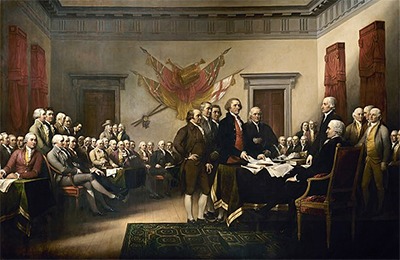
|
If bringing people together is an art form—and I believe that helping people work efficiently together certainly is—then the highest level of that art is leadership.
A “leader” may be defined, in the broadest possible sense, as one who accomplishes work or effort through the active participation of others. This definition would immediately rule out, then, the sort of supervisor, manager, or even chief executive who is so smart, experienced, or goal driven that he or she shoulders aside subordinates who are trying to do a task and completes it him- or herself, so that it gets “done right.” Such a person is not a leader but a star performer surrounded by frustrated assistants.
This is not to say that the leader cannot take a hand in the effort. After all, when invaders are pouring in over the walls, everyone picks up a rife and shoots. And yes, sometimes, the leader has to lay the first brick, make the first cut with the axe, or otherwise physically participate. This might be a ceremonial start to the project. Or it might be the leader demonstrating how he or she wants the task to be performed. And it may serve the psychological purpose of showing that the leader is not above getting his or her hands dirty. But for the most part, in day-to-day operations, the leader’s role is hands-off.
So how does a leader perform work “through the active participation of others”?
At first, it would seem that the leader simply gives orders. And this might work in situations and institutions where the command structure is clearly defined, enforced by rules and sanctions, and embedded by long-standing practice. Think of the Roman Catholic Church or the U.S. Army. Bishops have absolute authority over parish priests, and archbishops and cardinals have authority over bishops. Sergeants have absolute authority over privates, and lieutenants have authority over sergeants. And so on up and down the rigidly prescribed chain of command.
Except … a weak or vacillating bishop may have no effective control over the priests under him. A green or unskilled lieutenant may have no influence with an experienced, battle-hardened sergeant. Every organization, even the most hierarchical, has ways for underlings to evade or obstruct the orders they don’t like or can’t follow. In some cases, and with collusion, this might be a “white mutiny,” in which subordinates follow stupid orders to the letter until the whole effort—along with the command structure—just falls apart. And in the Vietnam War, there were supposedly incidents of “fragging,” in which soldiers rolled live grenades into the tents of incompetent officers whom they feared would get them killed in battle.
While simply giving orders can work in unusual or extreme situations, where other forms of leadership might take too long or be misunderstood, there is a further caution. In one of my favorite books, Dune by Frank Herbert, Duke Leto Atreides advises his son: “Give as few orders as possible. Once you’ve given orders on a subject, you must always give orders on that subject.” This is because people—especially those in a functioning command structure—can be fearfully literal-minded. They note and observe where a leader or a person up the line from them places his or her interest, attention, and focus. Written or verbal orders are specific and purposeful, and they will tend to be obeyed until rescinded or countermanded. And if the situation surrounding those orders changes in the slightest, the person receiving them will expect a new order amending the previous order. Otherwise, and fearful of doing something wrong or displeasing, they will follow the original order or wait, frozen, until the countermand arrives.
The trap with direct orders is always that they undermine personal initiative. “The chief said to do this and, so help me God, that’s what I’m doing.” Sometimes, perhaps with front-line soldiers in a shooting war, that kind of unthinking dedication and persistence is valuable. But few of us are engaged in a shooting war.
American business culture over the last seventy or eighty years has undergone a sea change. Coming out of World War II and into the boom times in which most of the returning soldiers found civilian jobs, the military-oriented, top-down, command-and-control structure was dominant. It worked to beat the Germans and the Japanese, so why not apply it to the assembly line and the sales floor? And that worked, too—so long as the boss was all-seeing and always right; the jobs were correctly structured and easily performed; and unusual situations were rarely encountered. It also worked because America was in its prime, being the last industrial country left standing, after Germany and Japan had been bombed flat, and England, France, and the rest of the world were exhausted by war. It was a good time for us Baby Boomers to grow up, because American business could make few lasting or damaging mistakes.
But soon, under pressure from rising global markets, advancing computer controls and information technology, and competition in a shrinking internal market, the rigid, top-down model started to falter. Employees who could only follow orders were not as nimble, flexible, or effective as those who had the initiative to identify problems and either fix them on the spot or recommend solutions to supervisors who tended to trust—rather than question—their judgment. Getting things right the first time on the assembly line avoids a lot of lost time in quality control, remediation, and recalls. Solving the customer’s problems on the sales floor avoids a lot of exchanges and restocking—not to mention loss of the customer’s good will.
The need for personal initiative has followed this cultural change back into the military. The modern army unit is no longer made up of people who shoulder a rifle, march in straight lines, and charge on command. The modern naval ship no longer needs teams of people who only pull on a rope when they are told. The modern battlefield is interconnected, data-heavy, and invisible to the naked eye. It is the place of “combined arms,” where soldiers on the ground coordinate intimately with air support, indirect artillery, and electronic intelligence sources. The modern soldier must be a team player, versed in complicated weapons systems—some of which he or she never personally handles—and react to a changing environment both flexibly and nimbly. The modern sailor is a technician operating one of the most complicated and versatile weapons systems ever made.
So how does a leader in either the modern business model or the modern military accomplish work “through the active participation of others”? Primarily, through articulating, setting, and enforcing values. Values are better guides to individual initiative than any set of standing or direct orders. Values last longer in the mind and memory. And when they are correctly stated and willingly adopted, they are more flexible in the face of emergent and changing situations.
The first value a leader must articulate, demonstrate, and encourage, is dedication to and respect for training. The modern soldier or employee needs to know every aspect of his or her own job, and it helps the person take initiative if he or she also understands and can on occasion fulfill the jobs of the people on either side, with whom the employee deals directly, and above, so that the employee understands the reason for and purpose of those orders and directions. Further, the employee should be educated in broader issues like the company’s or the unit’s mission, the needs of customers, the nature of the competition, and the factors leading to success. Some companies try to do this in blanket form with some sort of universal, homily-laded “mission statement” printed and laminated in posters that hang on the wall. But that’s the easy way out. If the mission is going to become a value embedded in the employee’s mind and heart, then it needs to be taught and refreshed at every opportunity.
The complementary value to training is trust: for the leader to trust that the employee has absorbed this knowledge and to encourage and reward the employee when he or she shows initiative. Without trust and encouragement, the employee will suspect that all of the training he or she has received was some sort of management gimmick. That Human Resources is manufacturing another “policy du jour,” a temporary thing like all the others, and what the company really wants is unquestioning obedience. That attitude taps into the vein of cynicism that lies not far beneath the skin of any alert and educated human being. And that sort of cynicism is poison to personal initiative.
Ultimately then, the leader establishes performance standards. This is the hands-on part of the job. The leader voices these directly: “This is how we do things.” “Here is what I expect.” And the leader rewards and publicly praises good performance: “That was well done.” “This is what success looks like.” Setting standards is not a do-once-and-done process. It cannot be achieved with a memo or a motivational poster. It is an active, repetitive, daily flow of discovery, example setting, and encouragement. The leader looks for occasions to teach and train to standards. Only with repetition and reinforcement do the values in all their varied applications become part of the team’s understanding and sense of purpose.
Modern leadership is more about persuasion than power. It treats people as willing participants with minds of their own, rather than as slaves, servants, or “meat robots” to be programmed. It is a personal relationship between supervisor and employee, between officer and soldier or sailor. It is built on mutual trust and respect, rather than on fear and obedience. And it takes conscious effort and an appreciation for the science of psychology and the art communication to establish this relationship.
But once the bond it made, it is stronger than any other. People will literally die for it.


